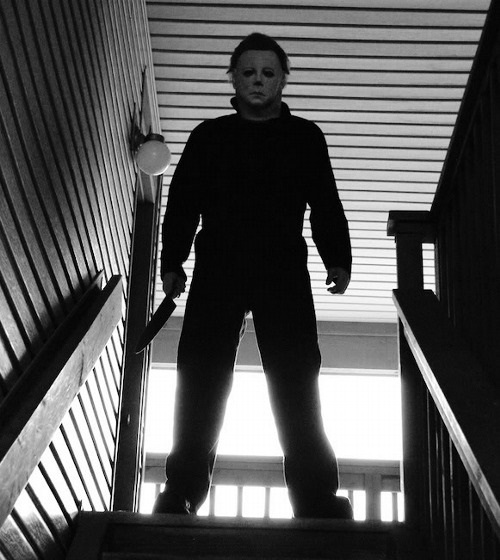Great teasers are expected in horror scripts – When you write a horror film, you HAVE to write a great teaser scene. It’s expected. The teaser in 2018’s Halloween was the most memorable scene in the film. And the same can be said for this Halloween – a boy wearing a mask murders his naked sister in POV. If a horror script gives me a lame teaser, it’s a guarantee that the rest of the script is going to be lame as well.
Bodies in motion – I like when scripts start with something HAPPENING. The characters are IN MOTION, on their way to something. In contrast, bad scripts often begin with characters sitting around. Nobody wants anything. Nobody’s trying to do anything. This sets the tone for a slow dull movie. Get your characters moving after the teaser, preferably doing something that sets the story in motion. After the teaser in Halloween, we cut to Dr. Loomis and a nurse in a car driving to the mental institution to talk to Michael. We’re off to the races already!
Save the Cat still works! – If you’re ever in doubt about whether your hero is likable enough, give them a Save the Cat! scene. It doesn’t even have to be some big production. Like saving an old woman from getting hit by a car. With Laurie, it’s a simple scene where she runs into the boy she’s babysitting that night. The boy clearly loves Laurie, and she’s adorable with him, adhering to all of his demands (watch a movie, make jack-o-lanters, read to him, make popcorn). It’s a short scene, but just like that kid, we now love Laurie as well. The scene speaks to the power of simplicity in storytelling, as pretty much every choice in Halloween is a simple one.
Build build build – In a horror movie, you don’t want your killer to start killing people right away. You want to BUILD towards it. Tease it. Draw out the suspense. Someone’s broken into the local hardware store and stolen a bunch of stuff. Laurie sees a strange figure in a mask standing across from the school. Then a couple of additional times, behind a bush, and in her yard. We’re building building building before the terror is unleashed.
The scariest things don’t have to be complicated – The reason Michael Myers is still terrifying after 40 years is that he’s so simple. A killing machine in an expressionless mask who never says a word. I bring this up only because people think today’s characters have to have really elaborate backstories and motivations. And while that works when done well, sometimes all you need is a simple terrifying monster.
Horror works best under a tight time constraint – Halloween takes place in less than a day. The majority of it takes place in real time. That’s when horror cooks the hottest, when the threat is so immediate that your characters have to deal with it NOW.
Integrate both active and passive storylines – One of the problems with these horror-slasher screenplays is that the victim is passive. Laurie doesn’t know that this man is after her. So she can’t go after anything herself. All she can do is live her life, and unfortunately, our lives are pretty boring. The solution to this is to add an active storyline. This is usually done by bringing in a policeman or detective who’s chasing the bad guy. Halloween does it with Dr. Loomis. He knows Michael will go back to Haddonfield, which is why he goes back there, to try and catch him. This allows you to cut back and forth between Laurie’s passive storyline and Dr. Loomis’s active one.
Dramatic Irony Alert – Remember that dramatic irony is when the audience knows something the character does not. It’s a device you should be using a lot as a horror writer. After Michael kills the guy who’s gone to grab a beer for his girlfriend, Michael puts on a sheet and walks upstairs to the girlfriend, who’s waiting in bed. She giggles when she sees her “boyfriend” in the sheet, and asks for her beer. WE know this isn’t her boyfriend. SHE does not. Hence the dramatic irony. This allows us to squirm and scream, desperately hoping she’ll find out before it’s too late.
The False Kill – Nearly every horror movie has a false kill of the monster/killer near the end of the film. Unfortunately, audiences have gotten hip to this and don’t believe it anymore. “Make sure he’s dead!” they’re screaming as the hero ignores this obvious advice. So if you’re going to do this these days, you want to use every trick in the book to convince the audience the monster is dead. That way, when they come back, we’re genuinely surprised. Unfortunately, Halloween is not one of these movies. Laurie weakly stabs Michael, who falls down behind a couch, and Laurie assumes he’s dead without even checking. Of course, only minutes later, he’s back on her trail.
We’ll forgive a basic plot if we like the hero – Yesterday I said that a cool plot cannot survive weak characters. The opposite is also true. A bad plot can be saved by strong characters. And when I say “characters,” I’m really talking about your hero. This might be the biggest screenwriting hack of all. If you give us a hero we really like, we’ll pretty much forgive everything else. Everything in Halloween is predictable. A killer escapes a mental institution. Some teenagers are baby-sitting that night. The killer finds them and kills them one-by-one. That’s basic horror movie 101. But we like Laurie so much that we don’t need a big fancy plot with lots of twists and turns. All we want is for her to survive. If that happens, we’ll have enjoyed the experience.



